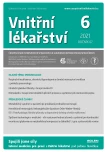Why we still don’t achieve blood pressure targets
Authors:
Vladimír Tuka; Aleš Linhart
Authors‘ workplace:
2. interní klinika – klinika kardiologie a angiologie VFN a 1. LF UK, Praha
Published in:
Vnitř Lék 2021; 67(6): 368-371
Category:
Overview
Arterial hypertension is one of the main modifiable risk factors for atherosclerotic cardiovascular disease. The prevalence of hypertension remains high, and its compensation is still unsatisfactory. In most patients, we should try to achieve office blood pressure values below 140/90 mm Hg, and in those who tolerate treatment well, values around 130/80 mm Hg, as soon as possible, ideally within three months of diagnosis. While lifestyle interventions are essential and should not be overlooked, most hypertensive patients cannot avoid pharmacotherapy, primarily using a combination of two or more antihypertensives. Achieving blood pressure targets, which determine the patient’s prognosis, is still not ideal. Factors on both the physician’s side and the patient’s side contribute to achieving blood pressure targets. The review article offers various approaches to achieving blood pressure targets, such as using fixed combinations.
Keywords:
fixed combination – arterial hypertension – therapeutic inertia – treatment adherence – treatment persistence
Sources
1. Williams B et al. ESC CardioMed, in Epidemiology and pathophysiology of hypertension. 2020, Oxford University Press.
2. Yusuf S et al. Effect of potentially modifiable risk factors associated with myocardial infarction in 52 countries (the INTERHEART study): case‑ control study. Lancet, 2004; 364(9438): 937–952.
3. Lustigová M, Čapková N. Prevalence rizikových faktorů srdečně‑ cévních onemocnění v Česku z pohledu demografických charakteristik – vybrané výsledky studie EHES. Demografie, 2017; 59(2): 162–170.
4. Cífková R et al. 30-year trends in major cardiovascular risk factors in the Czech population, Czech MONICA and Czech post‑MONICA, 1985–2016/17. PLoS One, 2020; 15(5): p. e0232845.
5. Kotseva K et al. Primary prevention efforts are poorly developed in people at high cardiovascular risk: A report from the European Society of Cardiology EURObservational Research Programme EUROASPIRE V survey in 16 European countries. European Journal of Preventive Cardiology. 0(0): p. 2047487320908698.
6. Kotseva K et al. EUROASPIRE IV: A European Society of Cardiology survey on the lifestyle, risk factor and therapeutic management of coronary patients from 24 European countries. European Journal of Preventive Cardiology, 2020; 23(6): 636–648.
7. Anand SS et al. Risk factors for myocardial infarction in women and men: insights from the INTERHEART study. European Heart Journal, 2008; 29(7): 932–940.
8. Mnatzaganian G et al. Socioeconomic disparities in the management of coronary heart disease in 438 general practices in Australia. European Journal of Preventive Cardiology. 0(0): p. 2047487320912087.
9. Ettehad D et al. Blood pressure lowering for prevention of cardiovascular disease and death: a systematic review and meta‑analysis. Lancet, 2016; 387(10022): 957–967.
10. Böhm M et al. Achieved blood pressure and cardiovascular outcomes in high‑risk patients: results from ONTARGET and TRANSCEND trials. Lancet, 2017; 389(10085): 2226–2237.
11. Williams B et al. 2018 ESC/ESH Guidelines for the management of arterial hypertension: The Task Force for the management of arterial hypertension of the European Society of Cardiology (ESC) and the European Society of Hypertension (ESH). European Heart Journal, 2018; 39(33): 3021–3104.
12. Hanssen H et al. Personalized exercise prescription in the prevention and treatment of arterial hypertension: a Consensus Document from the European Association of Preventive Cardiology (EAPC) and the ESC Council on Hypertension. European Journal of Preventive Cardiology, 2021.
13. Kjeldsen SE et al. Physician (investigator) inertia in apparent treatment‑resistant hypertension – Insights from large randomized clinical trials. Lennart Hansson Memorial Lecture. Blood Pressure, 2015; 24(1): 1–6.
14. Lebeau JP et al. The concept and definition of therapeutic inertia in hypertension in primary care: a qualitative systematic review. BMC Fam Pract, 2014; 15: p. 130.
15. Souček M. Adherence a perzistence se zaměřením na léčbu hypertenzních pacientů. Vnitřní lékařství, 2013; 59(6): 482–485.
16. Tuka V jr, Tuka V. Jak motivovat pacienta ke změně životního stylu? Vnitřní lékařství, 2020; 66(1): 60–61.
17. Vrijens B et al. Adherence to prescribed antihypertensive drug treatments: longitudinal study of electronically compiled dosing histories. Bmj, 2008; 336(7653): 1114–1117.
18. Jamerson K et al. Benazepril plus amlodipine or hydrochlorothiazide for hypertension in high‑risk patients. N Engl J Med, 2008; 359(23): 2417–2428.
19. Widimský J et al. Diagnostické a léčebné postupy u arteriální hypertenze – verze 2017. Doporučení České společnosti pro hypertenzi. Vnitřní lékařství, 2018; 64(7): 771–796.
20. Gradman AH et al. Initial combination therapy reduces the risk of cardiovascular events in hypertensive patients: a matched cohort study. Hypertension, 2013; 61(2): 309–318.
21. Simons LA. Long‑term persistence with single‑pill, fixed‑dose combination therapy versus two pills of amlodipine and perindopril for hypertension: Australian experience. Curr Med Res Opin. 2017 Oct; 33(10): 1783–1787.
Labels
Diabetology Endocrinology Internal medicineArticle was published in
Internal Medicine

2021 Issue 6
Most read in this issue
- Localised forms of pulmonary amyloidosis
- Hereditary hemorrhagic telangiectasia (Osler-Weber-Rendu syndrome) Part I. Pathophysiology, clinical symptoms and recommend screening for vascular malformations
- Respiratory insufficiency, chronic hypercapnia and domiciliary non-invasive ventilation from the point of view of a pneumologist
- Screening for gestational diabetes mellitus
